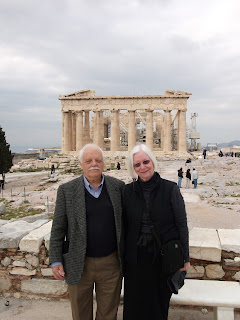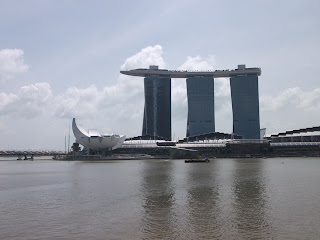During our week in Nicosia, Cyprus I spent some time every day at the university with our host Christos Xenophantos, later joined by Charlie Johnson who came from the US. (Charlie was heading to another venue in Europe but, by prearrangement, overlapped our stay in Nicosia for 4 days.) We stayed in a hotel in the old part of Nicosia, ringed by a still standing old wall and split in two by the "Green Line" that separates Greek Cyprus from Turkish Cyprus. There was much discussion of all this, and we have learned some recent history as a result which I will not repeat here. The Greek part of the old town is somewhat abandoned and a little seedy, with a small "touristic" section. Outside the walls there is a shopping district and a suburban-like district where the University is located. The island has a UN presence and a British military presence. as well as a long history. Mary Jo and I walked around some, and Mary Jo walked around a lot more and on Thursday took a 3-hour walking tour of the old, walled city centre of Nicosia, led by a Greek Cypriot woman. A free tour sponsored by the Tourist Information Center. Of the 10-11 on the tour several were Egyptian 'refugees' who had recently been airlifted to Nicosia by the UN. Among other things she showed us the elementary school she attended as a child and which is now attended by many Georgian children and other foreign nationals. According to her, the city center was abandoned by the Greek Cypriot community when the Turkish Cypriots invaded in 1974. Indeed we saw many closed and shuttered houses and shops. On Friday evening MJ, Charlie, and Bruce passed through the Green Line (passport required) and walked to a pleasant restaurant for dinner.
Our last day, Sunday, Mary Jo and I, with Charlie, took a cab to the shore in Turkish Cyprus. There we saw an old monastery, the house of the British writer Laurence Durrell (Bitter Lemons, Alexandria Quartet), and the harbor at Kyrenia, and had a nice dinner. In the evening I met Christo's parents, and learned that his father had taken English from Durrell while in high school. Monday we left for Florence and occupied our flat. It has a fine location but is not as nice as we had expected. It will do for the 3 weeks we are here, however.
A view from the monastery. This view reminds me of some paintings of our Landrum friend Carol Icard.
Mary Jo and Carlie at the top of the monastery.
View of hills in back of monastery
Former house of Laurence Durrell, with placque on wall.































